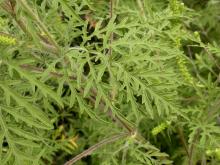Wildflowers, Grasses and Other Nonwoody Plants
Media

Species Types
Scientific Name
Pellaea atropurpurea
Description
Purple cliff brake is a fern that grows from crevices in limestone and dolomite rocks, or in rocky soils near them. Its leathery, blue-gray leaflets, which are oval to lance-shaped, make the fronds seem not very fernlike.
Media

Species Types
Scientific Name
Sagittaria spp.
Description
Arrowheads are aquatic plants with erect, usually arrow-shaped leaves and distinctive three-petaled flowers. They are often called duck potatoes because ducks, geese, and swans relish the tuberlike rootstocks.
Media

Species Types
Scientific Name
Chenopodium album
Description
Lamb’s quarters won’t win any beauty contests for its flowers, but it merits an award for being both a common garden weed as well as a nutritious leafy green valued around the world.
Media

Species Types
Scientific Name
Viola spp.
Description
Violets, as a group, are fairly easy to identify, with their colorful five-petaled “faces” so welcome in springtime. Missouri has 17 species, and some are confusingly similar. This page introduces them as a group.
Media

Species Types
Scientific Name
Ambrosia artemisiifolia
Description
Common ragweed is instantly recognizable by its ornate, 2–3 times pinnately lobed, hairy leaves. You’ve probably seen it many times and wondered what it was.
See Also
About Wildflowers, Grasses and Other Nonwoody Plants in Missouri
A very simple way of thinking about the green world is to divide the vascular plants into two groups: woody and nonwoody (or herbaceous). But this is an artificial division; many plant families include some species that are woody and some that are not. The diversity of nonwoody vascular plants is staggering! Think of all the ferns, grasses, sedges, lilies, peas, sunflowers, nightshades, milkweeds, mustards, mints, and mallows — weeds and wildflowers — and many more!





















